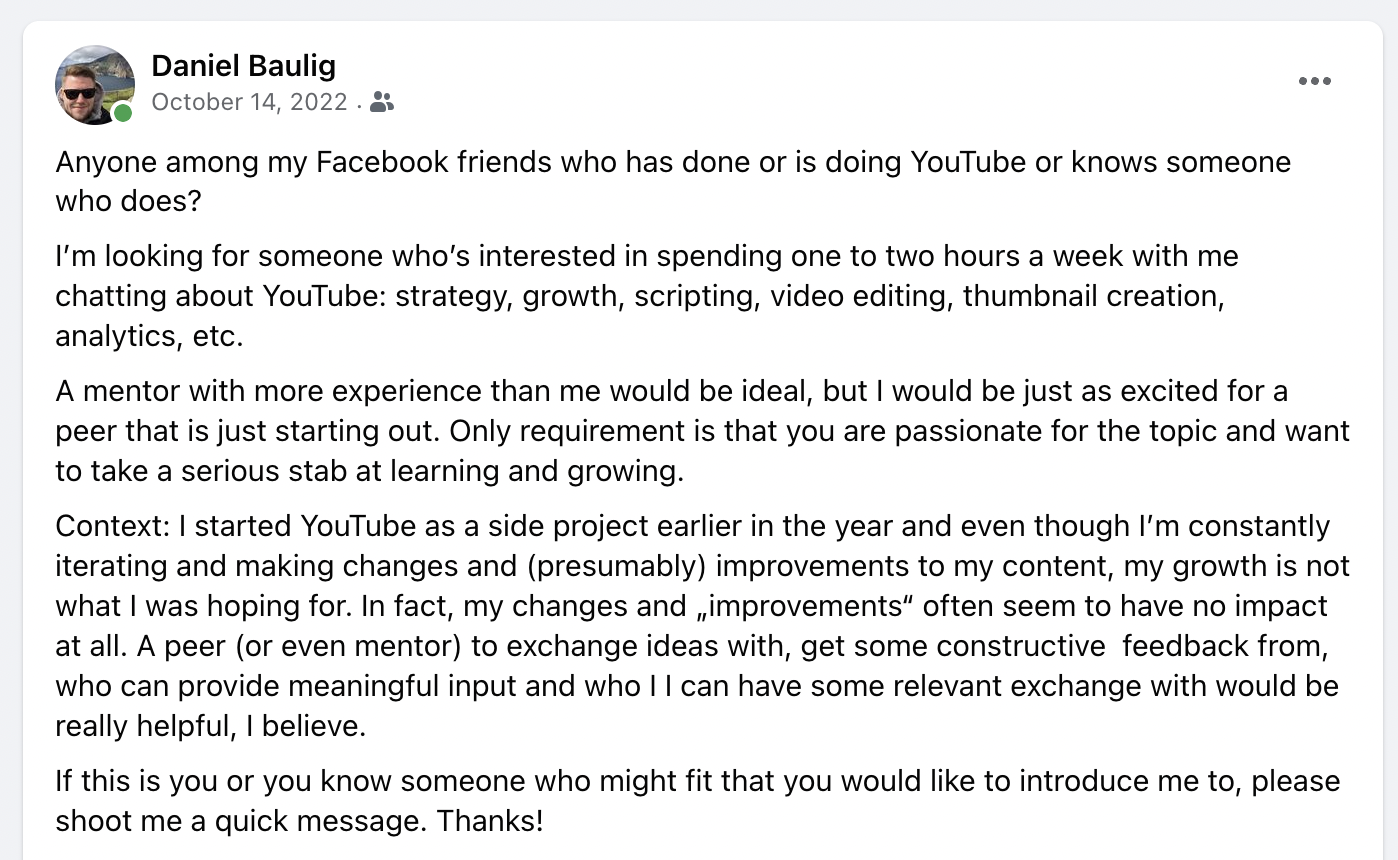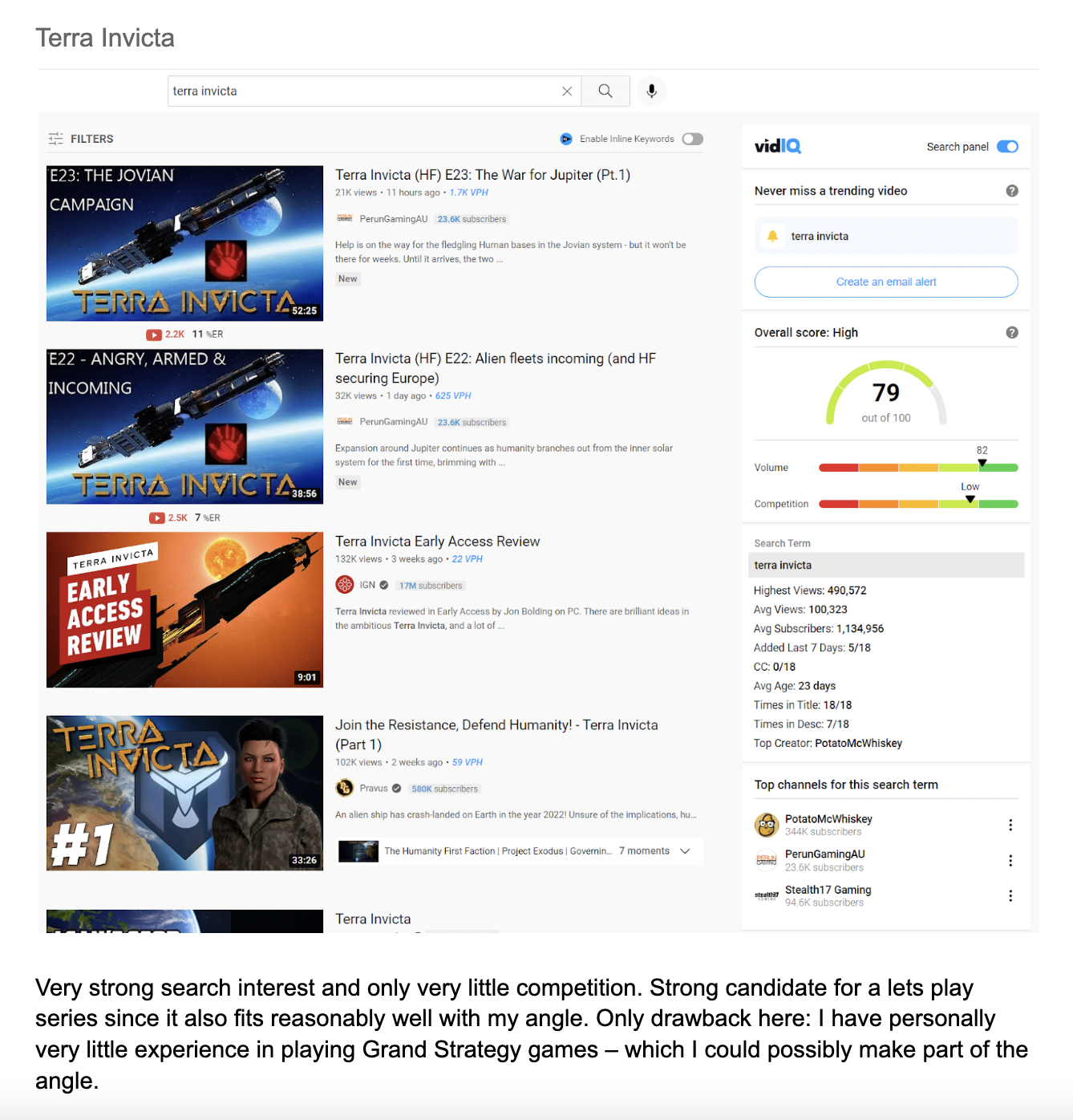How growth came through understanding myself and my audience

After I was facing declining viewership in late August and early September I decided I had to see if I could get some help from outside. I felt like my plan and approach of choosing a set of formats and games I was personally interested in and iterating on my execution around those wasn’t leading to growth and I needed some outside input on how to proceed.
A cry for help
Mid October I reached out to my social media network, looking for mentorship and/or peer feedback on my trajectory, strategy, thoughts, and execution in regards to my YouTube channel.

I was able to schedule calls with two acquaintances who were either doing YouTube themselves or were considering starting their own social media / video presence and had spent a lot of time thinking about the topic and how to be successful.
Feedback is a gift
When I started my YouTube journey, I thought I would be able to pickup and play whatever games I personally felt like and would be able to find an audience by iterating on and improving my “YouTube skills”, like editing, thumbnails, camera presence, etc.
And while it appears that the common wisdom is that there’s an audience for anything on the internet and that consistency and perseverance will lead to success, my personal experience was a different one. At the time though, I hadn’t fully bought into this idea yet and I was still thinking that if I just did the right improvements to my thumbnails or my editing, continued to work on camera presence, this would eventually feed back into growth of the channel.
After long and winded discussions with my two mentors I had a couple of realizations and came to a couple of conclusions. I would like the most important ones here:
- Click-Through Rate (CTR) does not exist in a vacuum, i.e. CTR is not just a function of how well a thumbnail and title are crafted.
- Topic relevance is king. E.g. a viewer not interested in video games, is exceptionally unlikely to watch any of my videos almost regardless of execution. This remains true as you narrow in on sub-genres (e.g. the specific game being played).
- Execution has most relevance when competing for non-returning viewers in a level playing field, i.e. when competing with other videos on the same topic or game.
- Expected performance of a video is a function of topic relevance and vs available competition (and it’s competitive strength and entrenchedness).
- I.e. a hot topic with a lot of competition might not actually be driving more engagement / clicks and might be hard to break into as a new channel.
- Finding an “angle” or “personal touch” is critical to retaining viewers and making them sticky, i.e. turning new viewers into returning viewers. It will allow those viewers to identify with me and will set me apart from the numerous alternative creators in the space. I had to focus on this IMMEDIATELY.
- Making viewers more sticky will improve CTR in itself, almost by definition. I.e. improving the bottom of the funnel will lead to an improvement at the top of the funnel, too. This was counter intuitive to me and took me quite a while to realize and embrace.
For people with a background in marketing or sales some of these bullets may seem obvious or even trivial. But to me, a dusty, nerdy engineer, they were not.
From these realizations I took away two major action items for myself:
- Undertake a self-evaluation to find my “angle” or “personal touch”
- Find a topic (i.e. game) that
- would fit well with and supported my “angle”
- had a favorable relevance to competition rate.
Understanding myself…
Before I was able to better understand my target audience I first had to understand myself better. I did an analysis of some of my personal favorite gaming and VR channels and took a closer look at what they each brought to the table. A simple bullet list with some major data points (like # of subscribers) and some adjectives that described the channel or host of the channel.
Obviously my selection of channels was biased by my own preferences, but in this case that was actually a positive. It would make sure that I personally could identify with the unique aspects of these channels and would make sure that I was potentially part of my own audience, which would make me more genuine and real.
A pattern quickly emerged. The following adjectives kept ending up on the list:
- technical
- nerdy
- little awkward
- top tier player
Clearly I am a big nerd, am hyper technical and can be awkward to be around at times. That said, the games that I was playing at the time were not supporting highlighting these character traits of me. But we’ll get back to that in just a second.
The last item on the bullet was a little more complicated. A lot of the creators I was following were clearly among the best players in there particular game. Not necessarily in the form of competitive play, but just in how well they understood and performed in their game, at least when compared to most more casual players. And this isn’t surprising, clearly each of them had spend thousands of hours in their respective games and most of them were literally professionals in the game: their creator career being their main source of income.
It was clear to me that I had to choose a game that would align well with my strengths but I wouldn’t just magically be a super strong player at any game I picked up. However, I realized that I didn’t necessarily needed to be a top tier player, I just had to push the boundaries on things further than most casual players would. I think MadMavn is a great example of a creator that shines not primarily through how perfect or flawless he executes in his games of choice, but primarily by setting the bar for himself much higher than most reasonable player would. While this leads to a lot of failure for him, it also provides something to viewers that they would not be able or willing to experience themselves directly.
In addition to the traits shared by some of my favorite creators I also took a closer look at some traits that separated me particularly from the pack of other “nerdy, slightly awkward and technical” creators. I came up with a rather long list (aren’t we all unique?) but the aspects I decided to focus on most were the following:
- German/Irish born living in the US
- Worked for almost a decade as high level Software Engineer at top tier Silicon Valley companies (i.e. MANGA).
Now that I had a better understanding of what I could bring to the table, it was time to look at and understand who my audience was and where I could find it.
…and my audience
The major question for me to better understand who my audience was, was to take a look at games that might fit well with my strengths and character traits. I started creating a list of genres that generally had relevance and supported or even required technical approaches or would be considered “nerdy”.
I had previously also realized that the more open ended and “sandboxy” a game is, the more I could bring creative problem solving into the mix. The more structured a game is, the less opportunity for that kind of angle would arise.
Some examples of genres on my list were sandbox games (e.g. Minecraft, Space Engineers), 4x games (e.g. Civilization 6), automation games (e.g. Factorio, Dyson Sphere Program), city builders (e.g. Cities: Skylines, Manor Lords), Grand Strategy (e.g. Terra Invicta), Rogue-likes (e.g. Slay the Spire, Domekeeper), programming games (e.g. Screeps), turn-based tactical games (e.g. XCOM 2), tactical RPGs (e.g. Baldurs Gate 3), survival Base-Building (e.g. No Man’s Sky, Medieval Dynasty).
This list is not exhaustive and you may not agree with the categorization of some of these games. But that’s not important. Rather, the next step was what was important: I did a “market analysis” for each of the games on my list.
I used various tools, but mostly Google Trends and VidIQ, to build an understanding on where in the competitive landscape each of these games resided. How big was the “potentially addressable market” for each of the games? How big was the search interest? How much competition, especially heavily entrenched competition was there?

In the end I had three titles on my short list. Each of them had a reasonable amount of interest from viewers and relatively little competition or at least not very much entrenched competition.
The titles were:
- Terra Invicta
- Dome Keeper
- Space Engineers
I decided to do a Let’s Try (one of the formats on my channel) on each of them, see how well they were received with my already existing audience and how well I personally liked them.
In the end, my decision fell on Space Engineers and my Let’s Play Space Engineers as a German Engineer series was born. Not only was the reception much better than for the other games, but I also felt like it’s sandboxy nature would match better with my creative problem solving approach and I could tap into the scripting parts of the game in ways that most other creators probably can’t. The whole Engineering thing also matched too well with my Software Engineering background and with the “as a German Engineer” spin I already had something that would set me apart from many other creators in an interesting and unique way.
Results
The launch of the Space Engineers series brought dramatic change to the channel and it’s growth trajectory. As of today I have gained almost 100 subscribers in the last 30 days and my channel has grown more than 4x since I posted the first Space Engineers video barely three months ago.

At this point the channel is well on track to reach the magic 1000 subscribers boundary to qualify for monetization well within this year. A dramatic change from last year, were I struggled most of the year to make any meaningful progress with growing my channel.
In the end I attribute the turn-around of the channel to two things in particular:
- Understanding myself…
- and understanding my audience.
While this seems so obvious in retrospect and as preached up and down in most YouTube creator guides, books and resources, before I actually went through those steps in a meaningful way and saw the results materialize, I did not understand these.
I hope my realization and success can also be yours. Thanks for reading.
 Boldly Unbuffed Blog
Boldly Unbuffed Blog